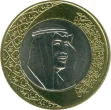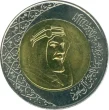Exchange your Saudi Riyals
Do you have leftover Saudi Riyals? We offer a fast and easy way to exchange both current and withdrawn Saudi Riyals banknotes and coins. Convert them into your local currency today with our quick and hassle-free exchange service.
ر.س - SAR
The Saudi Riyal has been in use since the 1920s and continues to support Saudi Arabia’s economy, particularly in the areas of oil exports and international trade.
Saudi Riyals Information
The Saudi Riyal (SAR) is the official currency of Saudi Arabia, one of the wealthiest nations in the Middle East due to its vast oil reserves. The Riyal was introduced in the 1920s, following the establishment of the Kingdom of Saudi Arabia. The name “Riyal” is derived from the Spanish word “real,” meaning “royal,” reflecting the historical use of silver coins in the region.
The Saudi Riyal is subdivided into 100 halalas, and the currency is issued in both coins and banknotes. Coins are available in denominations ranging from 1 halala to 2 riyals, while banknotes are issued in denominations of 5, 10, 50, 100, 200, and 500 riyals. The designs on Saudi Riyal banknotes feature important national symbols, including portraits of Saudi kings, images of the Kaaba in Mecca, and depictions of key infrastructure projects.
Saudi Arabia’s economy is heavily reliant on its oil exports, with the energy sector accounting for the majority of the country’s government revenues. The Saudi Riyal plays a central role in supporting the kingdom’s economic activities, particularly in its trade relationships with countries in Asia, Europe, and the United States. The stability of the Riyal is crucial for maintaining investor confidence and ensuring the smooth functioning of Saudi Arabia’s financial system.
The Saudi Central Bank (SAMA) is responsible for issuing the Saudi Riyal and managing the country’s monetary policy. The Riyal is pegged to the US Dollar at a fixed exchange rate,
which provides stability to the currency and helps safeguard the kingdom’s export-driven economy. SAMA’s primary objectives are to maintain price stability and promote financial stability.
One of the unique aspects of the Saudi Riyal is its use in the pilgrimage economy, as millions of Muslims travel to Saudi Arabia each year for the Hajj and Umrah pilgrimages. The Riyal’s stability and availability are critical for facilitating these religious journeys, which are a significant part of the Saudi economy.
In conclusion, the Saudi Riyal has been the official currency of Saudi Arabia for nearly a century and continues to play a vital role in supporting the kingdom’s economic growth
and trade. It remains a symbol of the country’s financial stability and its global importance in the energy sector.






















